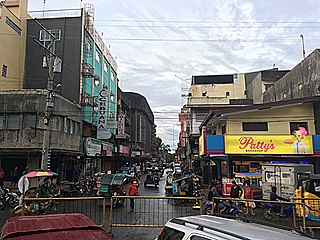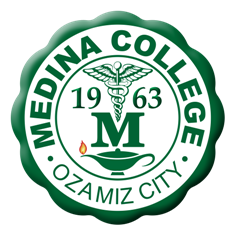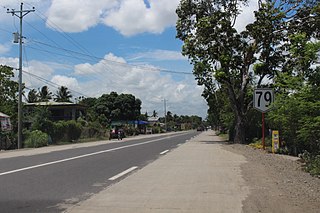
Zamboanga was a province of the Philippines located in the western region of the southern island of Mindanao, Philippines.

Zamboanga Peninsula is an administrative region in the Philippines, designated as Region IX. It consists of three provinces including four cities and the highly urbanized Zamboanga City. The region was previously known as Western Mindanao before the signing of Executive Order No. 36 of 2001. The city of Zamboanga was designated as the regional center until Pagadian was designated as its new regional center, although Zamboanga City remains the region's cultural, commercial, economic, and educational center.

Zamboanga Sibugay, officially the Province of Zamboanga Sibugay, is a province in the Philippines located in the Zamboanga Peninsula region in Mindanao. Its capital is Ipil and it borders Zamboanga del Norte to the north, Zamboanga del Sur to the east and Zamboanga City to the southwest. To the south lies Sibuguey Bay in the Moro Gulf.

Pagadian, officially the City of Pagadian, is a 1st class component city and the capital of the province of Zamboanga del Sur, Philippines. It is the regional center of Zamboanga Peninsula and the second-largest city in the region and in the province, after the independent city of Zamboanga. According to the 2020 census, it has a population of 210,452 people. The city will be converted to a highly urbanized city by the virtue of Proclamation No. 1247, signed by President Rodrigo Duterte dated November 8, 2021.

Ozamiz, officially the City of Ozamiz, is a 3rd class component city in the province of Misamis Occidental, Philippines. According to the 2020 census, it has a population of 140,334 people.

Mahayag, officially the Municipality of Mahayag, is a 3rd class municipality in the province of Zamboanga del Sur, Philippines. According to the 2020 census, it has a population of 48,258 people.

Molave, officially known as the Municipality of Molave, is a 1st class municipality in the province of Zamboanga del Sur, Philippines. In the 2020 census, it had 53,140 people. It is in the eastern part of the province of Zamboanga del Sur, and has an area of 21,685 hectares. The name "Molave" refers to the tree that was common in the area. Its economy is focused on agricultural production, and 1,378.5 hectares of fertile land is irrigated and planted with rice. Corn, coconut, cassava, banana, camote and various vegetables are also grown. These are marketed to neighboring towns and cities, and reach Cebu. Due to its strategic location, Molave is becoming the commercial hub of the Salug Valley. It is the most populous municipality in Zamboanga del Sur, and the third most populous in Region IX.

Universidad de Zamboanga (UZ) is a private nonsectarian coeducational higher education institution in Zamboanga City, Philippines, founded on October 12, 1948, by Engr. Arturo Eustaquio Sr. It was formerly known as Zamboanga A.E. Colleges until it changed its name to Universidad de Zamboanga on the 11th day of April 2005, the day it was granted university status.

The Roman Catholic Archdiocese of Ozamis is a metropolitan archdiocese of the Roman Catholic Church in the province of Misamis Occidental, southern Philippines. The archdiocese cathedral is the Metropolitan Cathedral of the Immaculate Conception in Ozamiz City, and its present archbishop is Martin Jumoad. The official spelling of the church is Ozamis, while the city it is located is Ozamiz.

Saint Columban College is a private, Catholic, coeducational basic and higher education institution run by the Roman Catholic Diocese of Pagadian in Pagadian City, Zamboanga del Sur, Philippines. Founded in 1957 as Saint Columban School, it is the largest among the Diocesan Schools of Pagadian. Columban offers primary, secondary and tertiary education. The Accountancy and Information Technology programs are distinguished as a Center for Excellence and Center for Excellence and Development, respectively.
Diocesan Schools Group of Pagadian is the network of sixteen schools under the administration and control of the Roman Catholic Diocese of Pagadian. The schools are governed by the Bishop of Pagadian, Most Rev. Emmanuel T. Cabajar, C.Ss.R, through the Diocesan Schools Superintendent, Rev. Foelan G. Echavez, M.A.

Medina General Hospital is a tertiary private hospital operating under Medina College, Inc. since June 1963. It is a base hospital of its main campus in Ozamiz City, Medina College-Ozamiz. It is one of the leading general hospitals in the country, with doctors that are deemed expert in different fields of medicine, including, pediatrics, geriatrics, cardiology, nephrology, neurology, oncology and surgical oncology, general surgery, orthopedics, pulmonology, and anesthesiology. As of February 2016, the hospital has equipped itself with 250 beds and in October 2017, new patient wards have been officially opened.

Medina College-Ozamiz, formerly Medina School of Midwifery, is a private, non-sectarian college in Ozamiz City, Philippines under Medina College Inc., which is deemed to be the first private midwifery school in Ozamiz. Much like its sister colleges in Pagadian and Ipil, which were founded some years later, the school is mainly concentrated in accommodating nursing students. Other academic programs, including engineering, criminology, arts and sciences, management and accountancy, are also offered.
Medina College is a trust-supported secondary school in Newport on the Isle of Wight, formerly Medina High School.
PBCom Rural Bank, formerly Banco Dipolog, Inc., was the 54th rural bank opened in the Philippines after the enactment of the Rural Banking Act of 1952. The late Justice Florentino Saguin, with the strong support of his son, Atty. Augusto “Tuting” Saguin, originally established it as the Rural Bank of Dipolog, Inc. (RBDI) on October 17, 1957, and opened its welcoming doors to the banking public on November 2, 1957.

National Route 79 (N79) is a 302-kilometer (188 mi), two-to-four lane national primary road connecting the provinces of Misamis Occidental, Zamboanga del Norte, and Zamboanga Sibugay. It traverses through many municipalities in Zamboanga del Norte and Misamis Occidental.

The Ozamiz–Pagadian Road, also known as Aurora–Ozamis Road, is a 70-kilometer (43 mi) two-to-four lane road network connecting the cities of Ozamiz in Misamis Occidental and Pagadian in Zamboanga del Sur. It traverses through Tangub and the municipality of Bonifacio at Misamis Occidental and the municipalities of Tambulig, Molave, Ramon Magsaysay, and Aurora at Zamboanga del Sur.

Medina College-Ipil is a private, non-sectarian higher education institution in Ipil, Zamboanga Sibugay. It was established by Dr. Rico Macan Medina, Sr. and his wife Dr. Beatriz Crisostomo Medina in June 2001, two years after its sister school in Pagadian was founded. The school offers Commission on Higher Education (CHED) recognized programs in Midwifery, Nursing, Pharmacy, Computer Science, Criminology, Elementary Education, Hotel and Restaurant Management.

Medina Foundation College of Sapang Dalaga, Inc. is a private non-sectarian higher education institution run by the Medina College, Inc. in Sapang Dalaga, Misamis Occidental. It was established by Medina College, Inc. in June 1984, exactly two decades after the main campus in Ozamiz City was founded. It is among the other private schools in Misamis Occidental which accommodates higher education programs in arts, elementary and secondary education, business administration, and junior secretarial courses.
















